coolant FIAT STRADA 2011 Owner handbook (in English)
[x] Cancel search | Manufacturer: FIAT, Model Year: 2011, Model line: STRADA, Model: FIAT STRADA 2011Pages: 195, PDF Size: 3.68 MB
Page 16 of 195
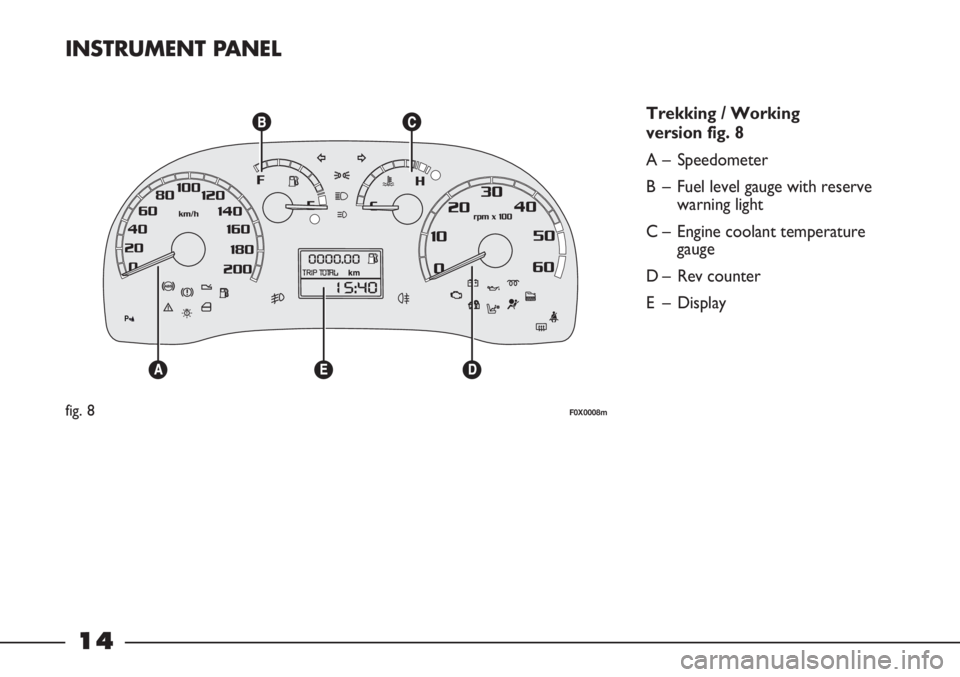
14
INSTRUMENT PANEL
Trekking / Working
version fig. 8
A – Speedometer
B – Fuel level gauge with reserve
warning light
C – Engine coolant temperature
gauge
D – Rev counter
E – Display
fig. 8F0X0008m
Page 17 of 195
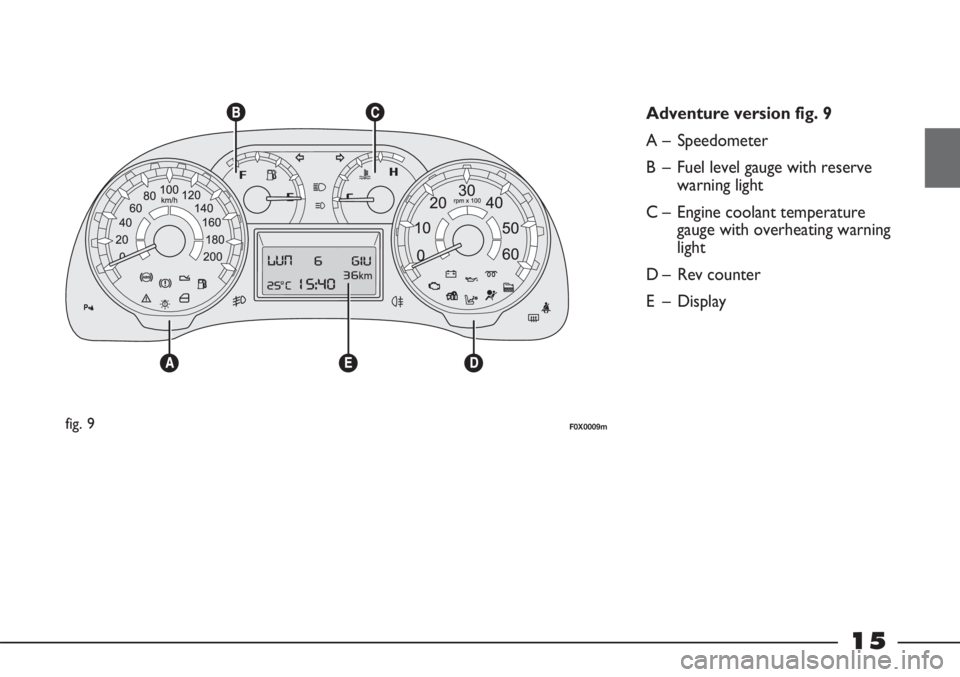
15
fig. 9F0X0009m
Adventure version fig. 9
A – Speedometer
B – Fuel level gauge with reserve
warning light
C – Engine coolant temperature
gauge with overheating warning
light
D – Rev counter
E – Display
Page 30 of 195
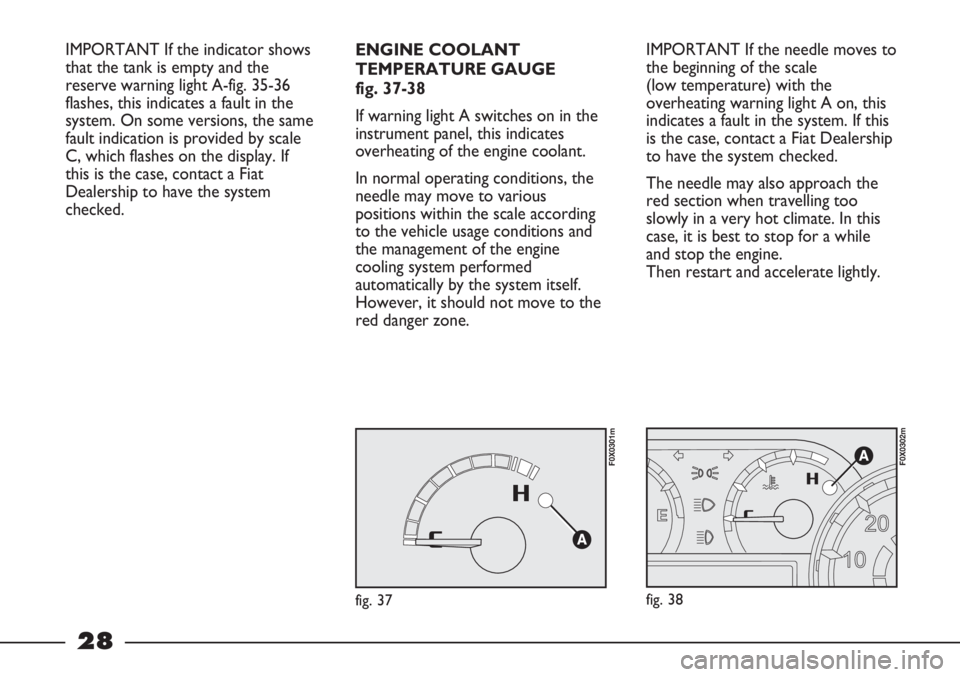
28
IMPORTANT If the needle moves to
the beginning of the scale
(low temperature) with the
overheating warning light A on, this
indicates a fault in the system. If this
is the case, contact a Fiat Dealership
to have the system checked.
The needle may also approach the
red section when travelling too
slowly in a very hot climate. In this
case, it is best to stop for a while
and stop the engine.
Then restart and accelerate lightly.
fig. 38
F0X0302m
ENGINE COOLANT
TEMPERATURE GAUGE
fig. 37-38
If warning light A switches on in the
instrument panel, this indicates
overheating of the engine coolant.
In normal operating conditions, the
needle may move to various
positions within the scale according
to the vehicle usage conditions and
the management of the engine
cooling system performed
automatically by the system itself.
However, it should not move to the
red danger zone.
fig. 37
F0X0301m
IMPORTANT If the indicator shows
that the tank is empty and the
reserve warning light A-fig. 35-36
flashes, this indicates a fault in the
system. On some versions, the same
fault indication is provided by scale
C, which flashes on the display. If
this is the case, contact a Fiat
Dealership to have the system
checked.
Page 59 of 195
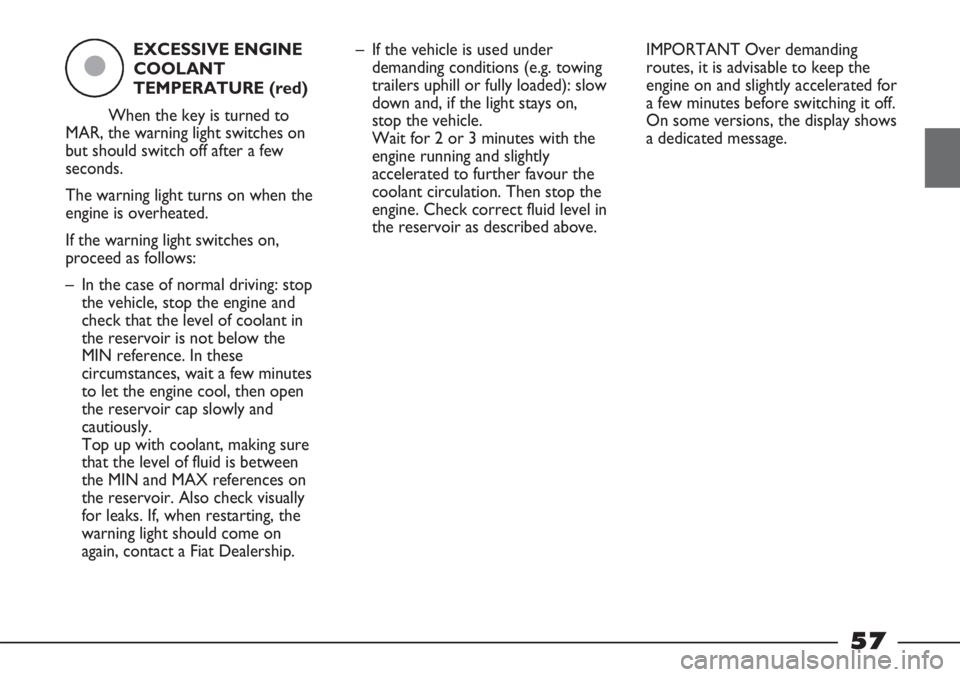
EXCESSIVE ENGINE
COOLANT
TEMPERATURE (red)
When the key is turned to
MAR, the warning light switches on
but should switch off after a few
seconds.
The warning light turns on when the
engine is overheated.
If the warning light switches on,
proceed as follows:
– In the case of normal driving: stop
the vehicle, stop the engine and
check that the level of coolant in
the reservoir is not below the
MIN reference. In these
circumstances, wait a few minutes
to let the engine cool, then open
the reservoir cap slowly and
cautiously.
Top up with coolant, making sure
that the level of fluid is between
the MIN and MAX references on
the reservoir. Also check visually
for leaks. If, when restarting, the
warning light should come on
again, contact a Fiat Dealership.
ç
– If the vehicle is used under
demanding conditions (e.g. towing
trailers uphill or fully loaded): slow
down and, if the light stays on,
stop the vehicle.
Wait for 2 or 3 minutes with the
engine running and slightly
accelerated to further favour the
coolant circulation. Then stop the
engine. Check correct fluid level in
the reservoir as described above.IMPORTANT Over demanding
routes, it is advisable to keep the
engine on and slightly accelerated for
a few minutes before switching it off.
On some versions, the display shows
a dedicated message.
57
Page 109 of 195
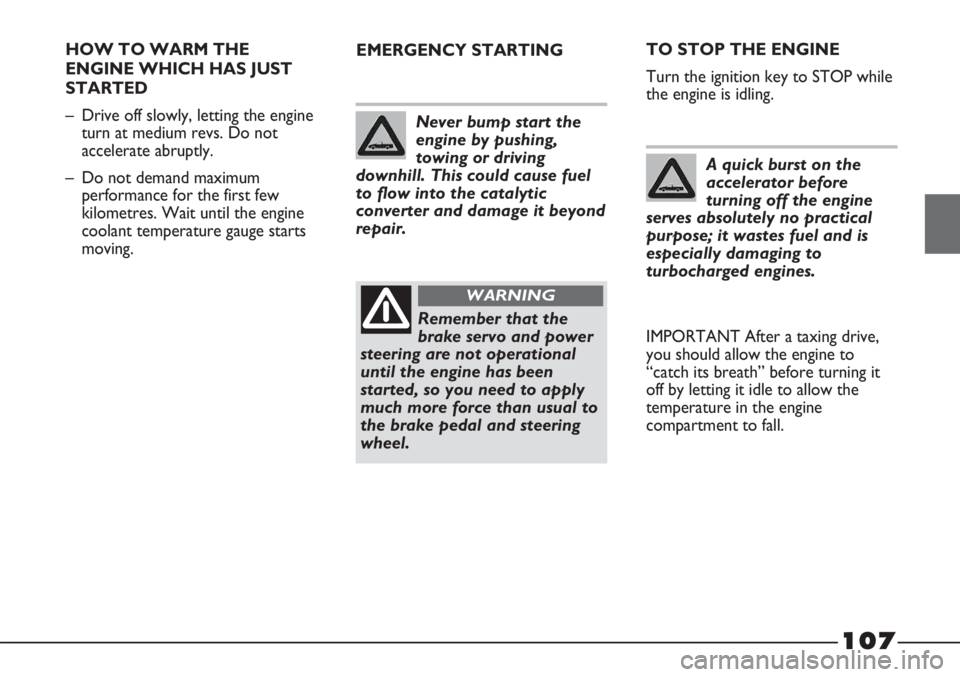
107
HOW TO WARM THE
ENGINE WHICH HAS JUST
STARTED
– Drive off slowly, letting the engine
turn at medium revs. Do not
accelerate abruptly.
– Do not demand maximum
performance for the first few
kilometres. Wait until the engine
coolant temperature gauge starts
moving.EMERGENCY STARTING
Never bump start the
engine by pushing,
towing or driving
downhill. This could cause fuel
to flow into the catalytic
converter and damage it beyond
repair.
Remember that the
brake servo and power
steering are not operational
until the engine has been
started, so you need to apply
much more force than usual to
the brake pedal and steering
wheel.
WARNING
TO STOP THE ENGINE
Turn the ignition key to STOP while
the engine is idling.
A quick burst on the
accelerator before
turning off the engine
serves absolutely no practical
purpose; it wastes fuel and is
especially damaging to
turbocharged engines.
IMPORTANT After a taxing drive,
you should allow the engine to
“catch its breath” before turning it
off by letting it idle to allow the
temperature in the engine
compartment to fall.
Page 147 of 195
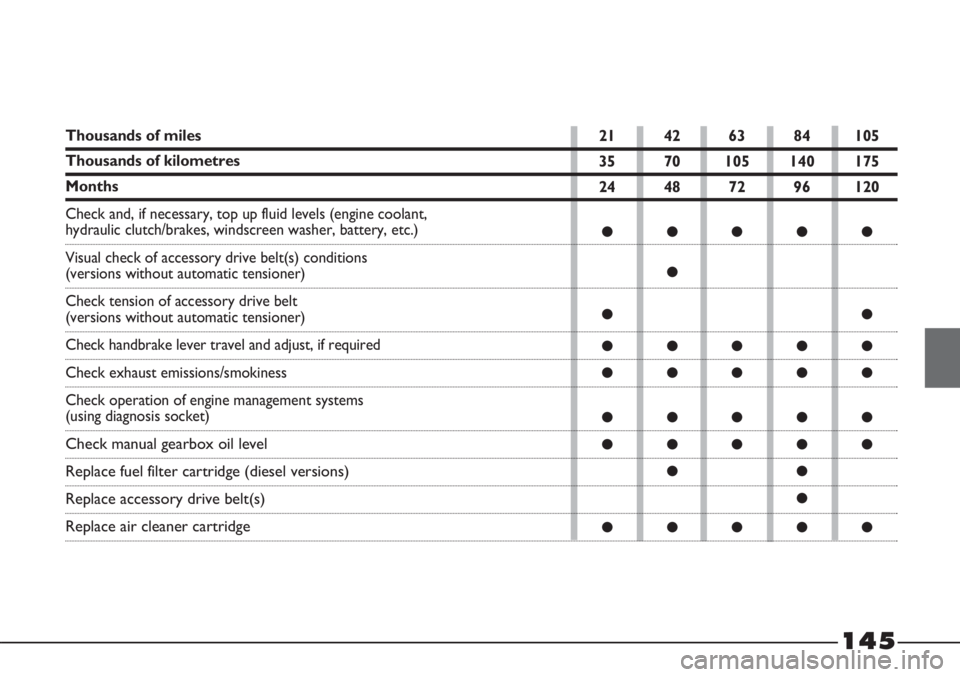
145
Thousands of miles
Thousands of kilometres
Months
Check and, if necessary, top up fluid levels (engine coolant,
hydraulic clutch/brakes, windscreen washer, battery, etc.)
Visual check of accessory drive belt(s) conditions
(versions without automatic tensioner)
Check tension of accessory drive belt
(versions without automatic tensioner)
Check handbrake lever travel and adjust, if required
Check exhaust emissions/smokiness
Check operation of engine management systems
(using diagnosis socket)
Check manual gearbox oil level
Replace fuel filter cartridge (diesel versions)
Replace accessory drive belt(s)
Replace air cleaner cartridge
21 42 63 84 105
35 70 105 140 175
24 48 72 96 120
●●●●●
●
●●
●●●●●
●●●●●
●●●●●
●●●●●
●●
●
●●●●●
Page 149 of 195
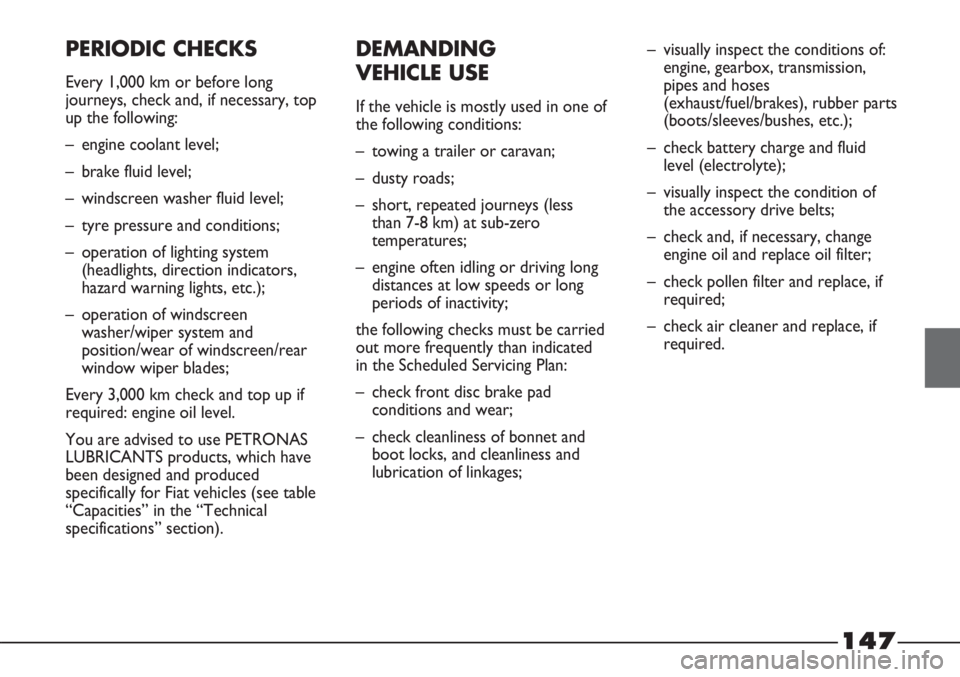
147
PERIODIC CHECKS
Every 1,000 km or before long
journeys, check and, if necessary, top
up the following:
– engine coolant level;
– brake fluid level;
– windscreen washer fluid level;
– tyre pressure and conditions;
– operation of lighting system
(headlights, direction indicators,
hazard warning lights, etc.);
– operation of windscreen
washer/wiper system and
position/wear of windscreen/rear
window wiper blades;
Every 3,000 km check and top up if
required: engine oil level.
You are advised to use PETRONAS
LUBRICANTS products, which have
been designed and produced
specifically for Fiat vehicles (see table
“Capacities” in the “Technical
specifications” section).
DEMANDING
VEHICLE USE
If the vehicle is mostly used in one of
the following conditions:
– towing a trailer or caravan;
– dusty roads;
– short, repeated journeys (less
than 7-8 km) at sub-zero
temperatures;
– engine often idling or driving long
distances at low speeds or long
periods of inactivity;
the following checks must be carried
out more frequently than indicated
in the Scheduled Servicing Plan:
– check front disc brake pad
conditions and wear;
– check cleanliness of bonnet and
boot locks, and cleanliness and
lubrication of linkages;– visually inspect the conditions of:
engine, gearbox, transmission,
pipes and hoses
(exhaust/fuel/brakes), rubber parts
(boots/sleeves/bushes, etc.);
– check battery charge and fluid
level (electrolyte);
– visually inspect the condition of
the accessory drive belts;
– check and, if necessary, change
engine oil and replace oil filter;
– check pollen filter and replace, if
required;
– check air cleaner and replace, if
required.
Page 150 of 195
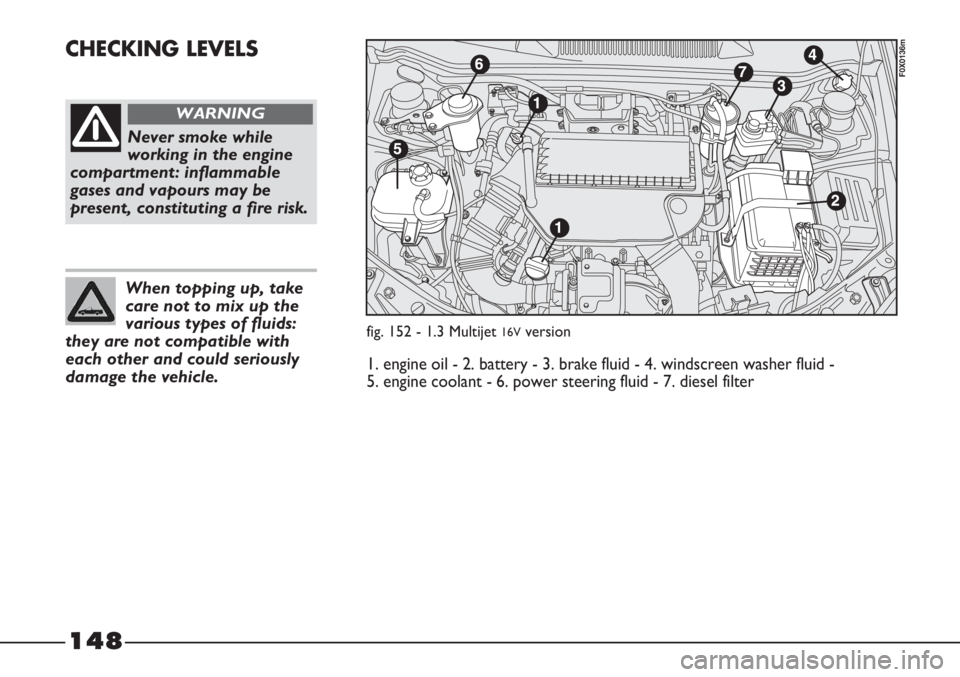
148
CHECKING LEVELS
Never smoke while
working in the engine
compartment: inflammable
gases and vapours may be
present, constituting a fire risk.
WARNING
When topping up, take
care not to mix up the
various types of fluids:
they are not compatible with
each other and could seriously
damage the vehicle.
fig. 152 - 1.3 Multijet 16Vversion
F0X0136m
1. engine oil - 2. battery - 3. brake fluid - 4. windscreen washer fluid -
5. engine coolant - 6. power steering fluid - 7. diesel filter
Page 152 of 195
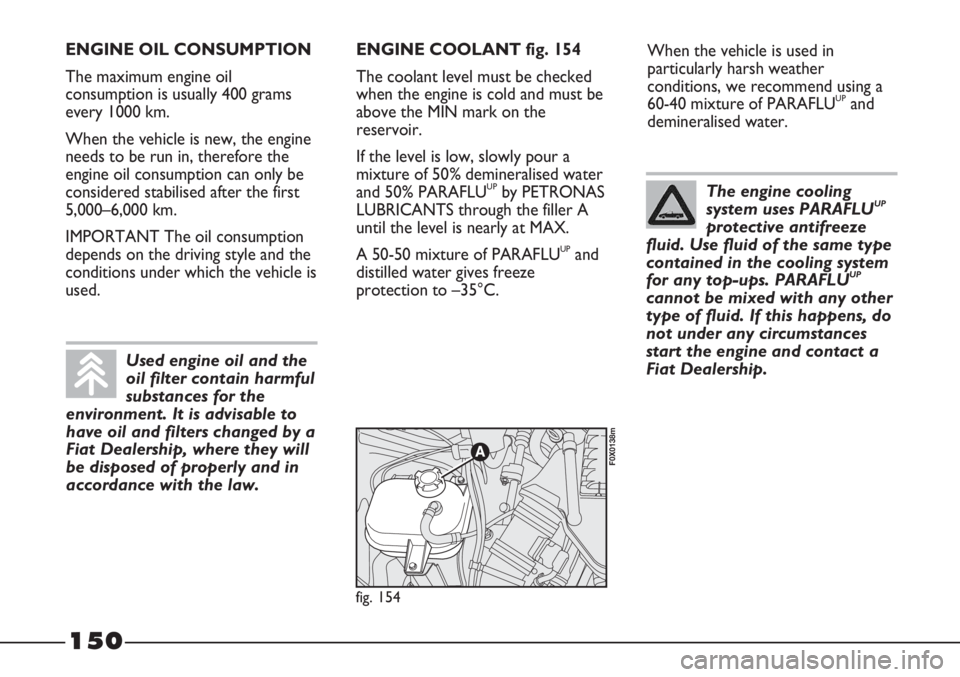
150
When the vehicle is used in
particularly harsh weather
conditions, we recommend using a
60-40 mixture of PARAFLU
UPand
demineralised water.
fig. 154
F0X0138m
ENGINE OIL CONSUMPTION
The maximum engine oil
consumption is usually 400 grams
every 1000 km.
When the vehicle is new, the engine
needs to be run in, therefore the
engine oil consumption can only be
considered stabilised after the first
5,000–6,000 km.
IMPORTANT The oil consumption
depends on the driving style and the
conditions under which the vehicle is
used.ENGINE COOLANT fig. 154
The coolant level must be checked
when the engine is cold and must be
above the MIN mark on the
reservoir.
If the level is low, slowly pour a
mixture of 50% demineralised water
and 50% PARAFLU
UPby PETRONAS
LUBRICANTS through the filler A
until the level is nearly at MAX.
A 50-50 mixture of PARAFLU
UPand
distilled water gives freeze
protection to –35°C.
Used engine oil and the
oil filter contain harmful
substances for the
environment. It is advisable to
have oil and filters changed by a
Fiat Dealership, where they will
be disposed of properly and in
accordance with the law.
The engine cooling
system uses PARAFLUUP
protective antifreeze
fluid. Use fluid of the same type
contained in the cooling system
for any top-ups. PARAFLU
UP
cannot be mixed with any other
type of fluid. If this happens, do
not under any circumstances
start the engine and contact a
Fiat Dealership.
Page 162 of 195
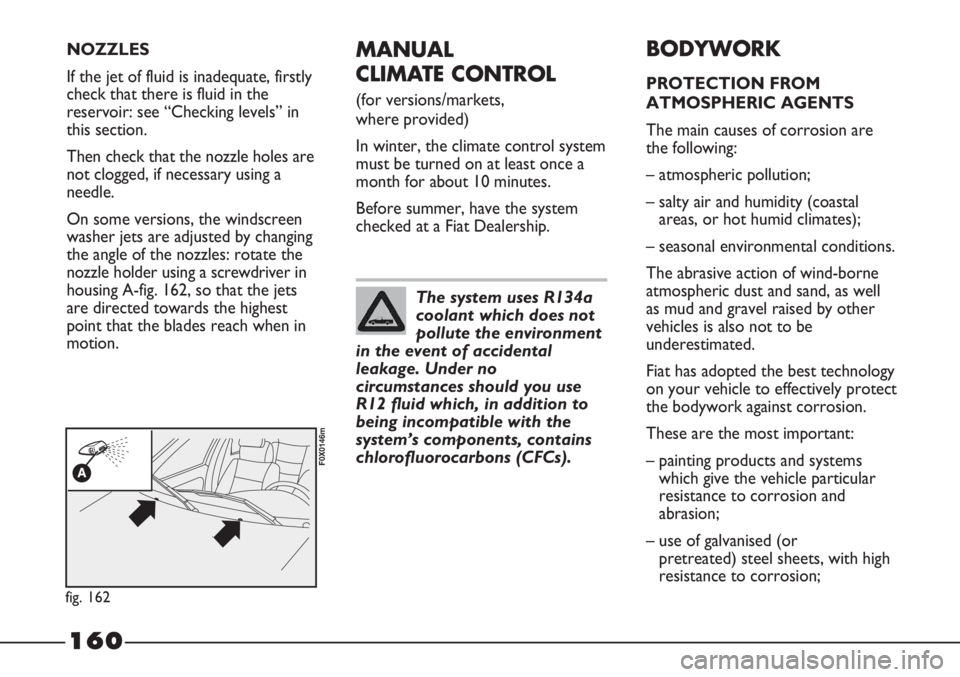
160
MANUAL
CLIMATE CONTROL
(for versions/markets,
where provided)
In winter, the climate control system
must be turned on at least once a
month for about 10 minutes.
Before summer, have the system
checked at a Fiat Dealership.
BODYWORK
PROTECTION FROM
ATMOSPHERIC AGENTS
The main causes of corrosion are
the following:
– atmospheric pollution;
– salty air and humidity (coastal
areas, or hot humid climates);
– seasonal environmental conditions.
The abrasive action of wind-borne
atmospheric dust and sand, as well
as mud and gravel raised by other
vehicles is also not to be
underestimated.
Fiat has adopted the best technology
on your vehicle to effectively protect
the bodywork against corrosion.
These are the most important:
– painting products and systems
which give the vehicle particular
resistance to corrosion and
abrasion;
– use of galvanised (or
pretreated) steel sheets, with high
resistance to corrosion;
The system uses R134a
coolant which does not
pollute the environment
in the event of accidental
leakage. Under no
circumstances should you use
R12 fluid which, in addition to
being incompatible with the
system’s components, contains
chlorofluorocarbons (CFCs).
NOZZLES
If the jet of fluid is inadequate, firstly
check that there is fluid in the
reservoir: see “Checking levels” in
this section.
Then check that the nozzle holes are
not clogged, if necessary using a
needle.
On some versions, the windscreen
washer jets are adjusted by changing
the angle of the nozzles: rotate the
nozzle holder using a screwdriver in
housing A-fig. 162, so that the jets
are directed towards the highest
point that the blades reach when in
motion.
fig. 162
F0X0146m